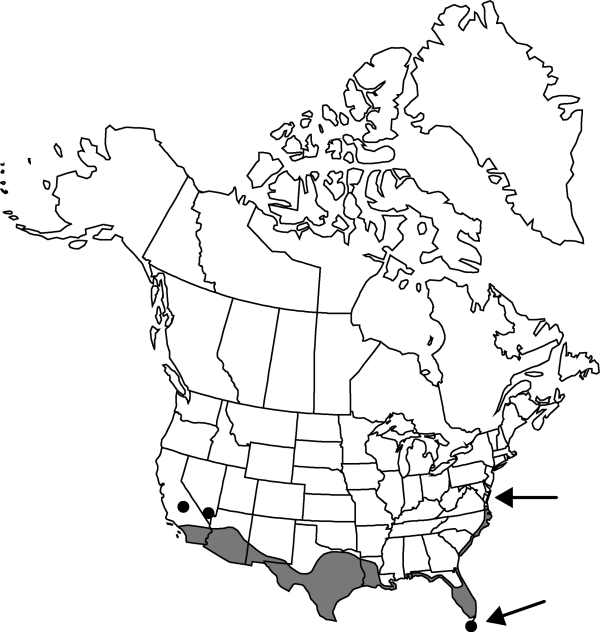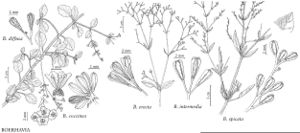Difference between revisions of "Boerhavia coccinea"
Gard. Dict. ed. 8, Boerhavia no. 4. 1768.
FNA>Volume Importer |
imported>Volume Importer |
||
| (7 intermediate revisions by 2 users not shown) | |||
| Line 8: | Line 8: | ||
}} | }} | ||
|common_names=Red spiderling;scarlet spiderling;hierba del cancer;hierba de la hormiga | |common_names=Red spiderling;scarlet spiderling;hierba del cancer;hierba de la hormiga | ||
| + | |special_status={{Treatment/ID/Special_status | ||
| + | |code=F | ||
| + | |label=Illustrated | ||
| + | }} | ||
|basionyms= | |basionyms= | ||
|synonyms={{Treatment/ID/Synonym | |synonyms={{Treatment/ID/Synonym | ||
|name=Boerhavia caribaea | |name=Boerhavia caribaea | ||
|authority=Jacquin | |authority=Jacquin | ||
| − | }}{{Treatment/ID/Synonym | + | |rank=species |
| + | }} {{Treatment/ID/Synonym | ||
|name=Boerhavia viscosa | |name=Boerhavia viscosa | ||
|authority=Lagasca & Rodríguez | |authority=Lagasca & Rodríguez | ||
| + | |rank=species | ||
}} | }} | ||
|hierarchy=Nyctaginaceae;Boerhavia;Boerhavia coccinea | |hierarchy=Nyctaginaceae;Boerhavia;Boerhavia coccinea | ||
| Line 23: | Line 29: | ||
}}<!-- | }}<!-- | ||
| − | --><span class="statement" id="st- | + | --><span class="statement" id="st-undefined" data-properties=""><b>Herbs,</b> perennial, often ± woody at base; taproot long and ropelike, woody. <b>Stems</b> prostrate to decumbent, usually profusely branched throughout, 3–15 dm, minutely pubescent, often glandular, sometimes spreading villous or hirsute in basal portions, minutely pubescent, sometimes glandular, glabrate, or glabrous distally. <b>Leaves</b> usually distributed throughout plant and into much of inflorescence; larger leaves with petiole 5–25 mm, blade broadly lanceolate, ovate, or broadly ovate, occasionally ± round, 20–70 × 10–60 mm (distal leaves smaller, often proportionally narrower), base truncate, broadly cuneate, or round, rarely cordate, margins sinuate, apex acute to obtuse or round, adaxial surface glabrous or sometimes sparsely puberulent, rarely densely glandular-pubescent, abaxial surface paler than adaxial surface, glabrous or sometimes sparsely puberulent, rarely densely glandular-pubescent, often with large multicellular hairs along veins, neither surface punctate. <b>Inflorescences</b> axillary or terminal, forked unequally ca. 3–6 times, open, without sticky internodal bands; branches divergent, terminating in compact subumbellate or capitate 5-flowered clusters. <b>Flowers</b>: pedicel shorter than 0.5 mm; bract at base of perianth usually quickly deciduous, 1, linear-lanceolate to ovate, 0.5–1 mm; perianth maroon, or magenta (or rarely white or yellow) [pink], campanulate beyond constriction, 1–3.5 mm; stamens 2–3, slightly exserted. <b>Fruits</b> (2–)5–20(–30) per cluster, gray-brown to brown, narrowly obovate and tapering at both ends or clavate, 2.6–4 × 0.9–1.2 mm (l/w: 2.7–3.5), apex rounded to rounded-conic, moderately densely to densely stipitate-glandular on ribs and in sulci; ribs 5, rounded, smooth; sulci 1–2.5 times as wide as base of ribs, not rugose, not papillate. <b>2n</b> = 52.</span><!-- |
-->{{Treatment/Body | -->{{Treatment/Body | ||
| + | |phenology=Flowering spring–winter [year-round]. | ||
|habitat=Roadsides, weedy areas, upper beaches, rocky slopes, gravelly outwash fans, arroyos in tropical scrub, arid grasslands, desert scrub, pinyon-juniper woodlands | |habitat=Roadsides, weedy areas, upper beaches, rocky slopes, gravelly outwash fans, arroyos in tropical scrub, arid grasslands, desert scrub, pinyon-juniper woodlands | ||
|elevation=0-2000 m | |elevation=0-2000 m | ||
|distribution=Ala.;Ariz.;Calif.;Fla.;La.;Md.;Nev.;N.Mex.;N.C.;S.C.;Tex.;Va.;Mexico;West Indies;Central America;South America;Eurasia;Africa;Australia. | |distribution=Ala.;Ariz.;Calif.;Fla.;La.;Md.;Nev.;N.Mex.;N.C.;S.C.;Tex.;Va.;Mexico;West Indies;Central America;South America;Eurasia;Africa;Australia. | ||
| − | |discussion=<p>Boerhavia coccinea is weedy and probably adventive along the Gulf and southern Atlantic coasts in North America; it can be expected in waste areas anywhere in that region. Worldwide, it probably also has a broader range than indicated, particularly on oceanic islands. The complex, which is in need of taxonomic clarification, is extremely variable with regard to robustness, pubescence, and fruit number in individual terminal inflorescences. In the New World, flowers are usually some shade of deep wine red, although populations of white-flowered or yellow-flowered plants are rarely found (R. Spellenberg 2000). In the Old World, pink-flowered plants are frequent (C. Whitehouse 1996).</p> | + | |discussion=<p><i>Boerhavia coccinea</i> is weedy and probably adventive along the Gulf and southern Atlantic coasts in North America; it can be expected in waste areas anywhere in that region. Worldwide, it probably also has a broader range than indicated, particularly on oceanic islands. The complex, which is in need of taxonomic clarification, is extremely variable with regard to robustness, pubescence, and fruit number in individual terminal inflorescences. In the New World, flowers are usually some shade of deep wine red, although populations of white-flowered or yellow-flowered plants are rarely found (R. Spellenberg 2000). In the Old World, pink-flowered plants are frequent (C. Whitehouse 1996).</p> |
|tables= | |tables= | ||
|references= | |references= | ||
| Line 38: | Line 45: | ||
-->{{#Taxon: | -->{{#Taxon: | ||
name=Boerhavia coccinea | name=Boerhavia coccinea | ||
| − | |||
|authority=Miller | |authority=Miller | ||
|rank=species | |rank=species | ||
| Line 45: | Line 51: | ||
|basionyms= | |basionyms= | ||
|family=Nyctaginaceae | |family=Nyctaginaceae | ||
| + | |phenology=Flowering spring–winter [year-round]. | ||
|habitat=Roadsides, weedy areas, upper beaches, rocky slopes, gravelly outwash fans, arroyos in tropical scrub, arid grasslands, desert scrub, pinyon-juniper woodlands | |habitat=Roadsides, weedy areas, upper beaches, rocky slopes, gravelly outwash fans, arroyos in tropical scrub, arid grasslands, desert scrub, pinyon-juniper woodlands | ||
|elevation=0-2000 m | |elevation=0-2000 m | ||
| Line 51: | Line 58: | ||
|publication title=Gard. Dict. ed. | |publication title=Gard. Dict. ed. | ||
|publication year=1768 | |publication year=1768 | ||
| − | |special status= | + | |special status=Illustrated |
| − | |source xml=https:// | + | |source xml=https://bitbucket.org/aafc-mbb/fna-data-curation/src/2e0870ddd59836b60bcf96646a41e87ea5a5943a/coarse_grained_fna_xml/V4/V4_27.xml |
|genus=Boerhavia | |genus=Boerhavia | ||
|species=Boerhavia coccinea | |species=Boerhavia coccinea | ||
| − | |||
| − | |||
| − | |||
| − | |||
| − | |||
| − | |||
| − | |||
| − | |||
| − | |||
| − | |||
| − | |||
| − | |||
| − | |||
| − | |||
| − | |||
| − | |||
| − | |||
| − | |||
| − | |||
| − | |||
| − | |||
| − | |||
| − | |||
| − | |||
| − | |||
| − | |||
| − | |||
| − | |||
| − | |||
| − | |||
| − | |||
| − | |||
| − | |||
| − | |||
| − | |||
| − | |||
| − | |||
| − | |||
| − | |||
| − | |||
| − | |||
| − | |||
| − | |||
| − | |||
| − | |||
| − | |||
| − | |||
}}<!-- | }}<!-- | ||
-->[[Category:Treatment]][[Category:Boerhavia]] | -->[[Category:Treatment]][[Category:Boerhavia]] | ||
Latest revision as of 21:57, 5 November 2020
Herbs, perennial, often ± woody at base; taproot long and ropelike, woody. Stems prostrate to decumbent, usually profusely branched throughout, 3–15 dm, minutely pubescent, often glandular, sometimes spreading villous or hirsute in basal portions, minutely pubescent, sometimes glandular, glabrate, or glabrous distally. Leaves usually distributed throughout plant and into much of inflorescence; larger leaves with petiole 5–25 mm, blade broadly lanceolate, ovate, or broadly ovate, occasionally ± round, 20–70 × 10–60 mm (distal leaves smaller, often proportionally narrower), base truncate, broadly cuneate, or round, rarely cordate, margins sinuate, apex acute to obtuse or round, adaxial surface glabrous or sometimes sparsely puberulent, rarely densely glandular-pubescent, abaxial surface paler than adaxial surface, glabrous or sometimes sparsely puberulent, rarely densely glandular-pubescent, often with large multicellular hairs along veins, neither surface punctate. Inflorescences axillary or terminal, forked unequally ca. 3–6 times, open, without sticky internodal bands; branches divergent, terminating in compact subumbellate or capitate 5-flowered clusters. Flowers: pedicel shorter than 0.5 mm; bract at base of perianth usually quickly deciduous, 1, linear-lanceolate to ovate, 0.5–1 mm; perianth maroon, or magenta (or rarely white or yellow) [pink], campanulate beyond constriction, 1–3.5 mm; stamens 2–3, slightly exserted. Fruits (2–)5–20(–30) per cluster, gray-brown to brown, narrowly obovate and tapering at both ends or clavate, 2.6–4 × 0.9–1.2 mm (l/w: 2.7–3.5), apex rounded to rounded-conic, moderately densely to densely stipitate-glandular on ribs and in sulci; ribs 5, rounded, smooth; sulci 1–2.5 times as wide as base of ribs, not rugose, not papillate. 2n = 52.
Phenology: Flowering spring–winter [year-round].
Habitat: Roadsides, weedy areas, upper beaches, rocky slopes, gravelly outwash fans, arroyos in tropical scrub, arid grasslands, desert scrub, pinyon-juniper woodlands
Elevation: 0-2000 m
Distribution

Ala., Ariz., Calif., Fla., La., Md., Nev., N.Mex., N.C., S.C., Tex., Va., Mexico, West Indies, Central America, South America, Eurasia, Africa, Australia.
Discussion
Boerhavia coccinea is weedy and probably adventive along the Gulf and southern Atlantic coasts in North America; it can be expected in waste areas anywhere in that region. Worldwide, it probably also has a broader range than indicated, particularly on oceanic islands. The complex, which is in need of taxonomic clarification, is extremely variable with regard to robustness, pubescence, and fruit number in individual terminal inflorescences. In the New World, flowers are usually some shade of deep wine red, although populations of white-flowered or yellow-flowered plants are rarely found (R. Spellenberg 2000). In the Old World, pink-flowered plants are frequent (C. Whitehouse 1996).
Selected References
None.
